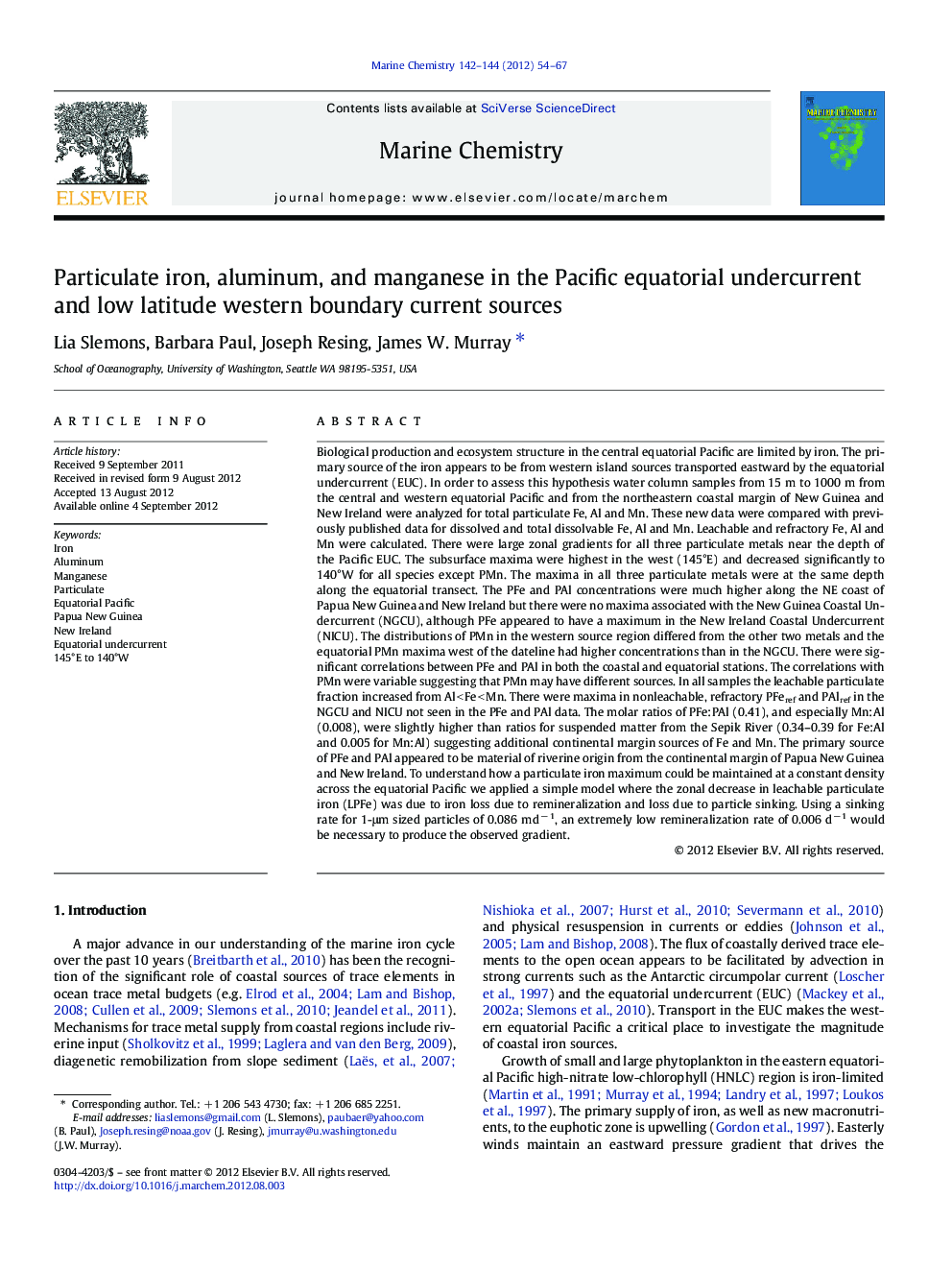| کد مقاله | کد نشریه | سال انتشار | مقاله انگلیسی | نسخه تمام متن |
|---|---|---|---|---|
| 1263289 | 1496689 | 2012 | 14 صفحه PDF | دانلود رایگان |

Biological production and ecosystem structure in the central equatorial Pacific are limited by iron. The primary source of the iron appears to be from western island sources transported eastward by the equatorial undercurrent (EUC). In order to assess this hypothesis water column samples from 15 m to 1000 m from the central and western equatorial Pacific and from the northeastern coastal margin of New Guinea and New Ireland were analyzed for total particulate Fe, Al and Mn. These new data were compared with previously published data for dissolved and total dissolvable Fe, Al and Mn. Leachable and refractory Fe, Al and Mn were calculated. There were large zonal gradients for all three particulate metals near the depth of the Pacific EUC. The subsurface maxima were highest in the west (145°E) and decreased significantly to 140°W for all species except PMn. The maxima in all three particulate metals were at the same depth along the equatorial transect. The PFe and PAl concentrations were much higher along the NE coast of Papua New Guinea and New Ireland but there were no maxima associated with the New Guinea Coastal Undercurrent (NGCU), although PFe appeared to have a maximum in the New Ireland Coastal Undercurrent (NICU). The distributions of PMn in the western source region differed from the other two metals and the equatorial PMn maxima west of the dateline had higher concentrations than in the NGCU. There were significant correlations between PFe and PAl in both the coastal and equatorial stations. The correlations with PMn were variable suggesting that PMn may have different sources. In all samples the leachable particulate fraction increased from Al < Fe < Mn. There were maxima in nonleachable, refractory PFeref and PAlref in the NGCU and NICU not seen in the PFe and PAl data. The molar ratios of PFe:PAl (0.41), and especially Mn:Al (0.008), were slightly higher than ratios for suspended matter from the Sepik River (0.34–0.39 for Fe:Al and 0.005 for Mn:Al) suggesting additional continental margin sources of Fe and Mn. The primary source of PFe and PAl appeared to be material of riverine origin from the continental margin of Papua New Guinea and New Ireland. To understand how a particulate iron maximum could be maintained at a constant density across the equatorial Pacific we applied a simple model where the zonal decrease in leachable particulate iron (LPFe) was due to iron loss due to remineralization and loss due to particle sinking. Using a sinking rate for 1-μm sized particles of 0.086 m d− 1, an extremely low remineralization rate of 0.006 d− 1 would be necessary to produce the observed gradient.
► Large zonal gradients for particulate Fe, Al and Mn in the Pacific equatorial undercurrent
► The maxima were at the same depth in the equatorial transect.
► The leachable particulate fraction increased from Al < Fe < Mn
► The origin appears to be from the continental margin of Papua New Guinea and New Ireland.
► A simple model suggests that the remineralization rate must be very low.
Journal: Marine Chemistry - Volumes 142–144, 10 October 2012, Pages 54–67